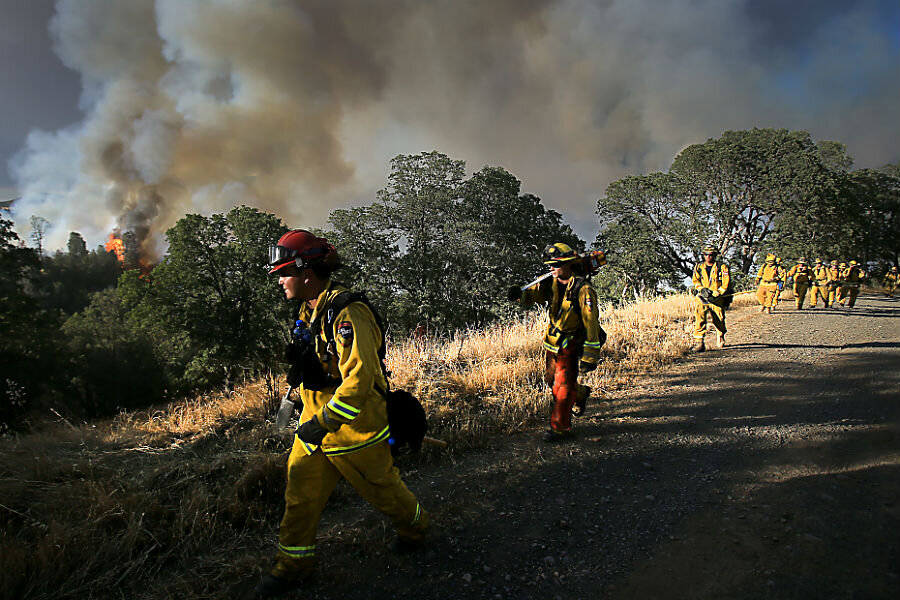Lower Lake wildfire prompts more home evacuations
Loading...
| Lower Lake, Calif.
For the second time in as many weeks, residents had to evacuate their homes after a new wildfire erupted near a destructive blaze that has been burning for days in Northern California's rocky hills north of San Francisco.
The new blaze, which erupted Sunday several miles away from the community of Lower Lake, had burned 9 square miles by Monday, the California Department of Forestry and Fire Protection said.
Evacuations were ordered after the fire doubled in size overnight.
Authorities couldn't say how many homes were evacuated or how many people were told to be prepared to flee. The fire was burning about 100 miles north of San Francisco.
No homes have been destroyed and no injuries have been reported.
Meanwhile, firefighters have nearly surrounded the larger blaze that started about two weeks ago and burned 109 square miles.
That fire destroyed 43 homes, but all evacuations have been lifted. Students in the Middletown Unified School District could start classes next Tuesday, but it might be later depending on where the fire burns.
Fire officials are investigating the causes of both fires. There have been five arson arrests related to smaller fires in five weeks.
Here's a look at other wildfires burning up Western states:
EVACUATIONS LIFTED
Authorities lifted evacuation orders for most of the 1,000 homes threatened by a wildfire near the Arizona-California line, one of several blazing across the tinder-dry West.
The fire in Arizona's Mohave Valley area chewed through 10 square miles and remained uncontrolled Monday.
Evacuation orders were lifted for 900 homes after crews made solid efforts in protecting them and conditions became more favorable, said Byron Steward, Mohave County emergency management coordinator.
The wildfire broke out Saturday in the Havasu National Wildlife Refuge. Authorities say it has burned 11 homes but it was not known if they were damaged or destroyed.
The fire's cause is under investigation.
Save the burro
Firefighters found themselves with a four-legged companion as they provided structure protection near a blaze in northwestern Arizona.
The Havasu News reports five Desert Hills firefighters were in the Bullhead City area for about an hour Saturday afternoon when a burro approached them.
Desert Hills Fire Chief Bill Weber says they hosed off the scared animal and worked alongside the burro until they were redeployed.
It's unclear whether the donkey was a wild or domesticated burro.
A fire official says a rescue group is planning to send a representative to help the donkey.
MOTOR-HOME BLAZE SPARKS WILDFIRE
A motor-home fire-turned-wildfire in rural Riverside County has surged to about 500 acres, forcing evacuations and leaving one person with a burn injury and three firefighters with minor injuries.
The blaze off State Route 74 near Anza started as a motor home blaze that spread to vegetation on Monday afternoon.
State fire officials say one person from the motor home had serious burns, but only to about 3 percent of their body. Three firefighters were taken to hospitals with minor injuries suffered while taking on the blaze.
Residents of five streets in the area have been told to evacuate, but it's not clear how many homes or people are affected.
The fire is about halfway between Temecula and Palm Desert. It's 10 percent contained.
FIREFIGHTERS KILLED
A U.S. Forest Service firefighter was killed in the Lake Tahoe area after he was struck by a tree while battling a wildfire — the second firefighter killed in a California blaze since the summer wildfire season got underway.
Michael Hallenbeck, 21, of Shingle Springs, California, was hit Saturday during the initial attack on a fire that broke out south of the Echo Summit mountain pass.
On July 30, a firefighter was killed by a wildfire in the Modoc National Forest while he scouted the area for ways to fight the blaze. Forest Service firefighter David Ruhl, of Rapid City, South Dakota, had been on temporary assignment since June in California.
On Sunday, hundreds of people turned out in Rapid City to pay their respects at a procession and memorial service for Ruhl. Forest Service Associate Chief Mary Wagner attended, saying Ruhl's death was "felt by every member of the Forest Service."
ELSEWHERE IN THE WEST
— Overcast skies and higher humidity helped fire crews get a preliminary line around a wildfire in Lewis County, Washington. Evacuations have been lifted, and there have been no reports of injuries.
While the cooler weather is helping firefighting efforts, crews are keeping an eye on thunderstorms that are in the forecast for later Monday.
— Fire crews are working to control a blaze that has spread across nearly 2 square miles on Oahu, Hawaii, and led to evacuations. No structures were damaged Monday. Part of Highway 270 closed when a pile of timber caught fire.
— A fire that started nearly three weeks ago near St. Mary Lake in Montana's Glacier National Park has burned nearly 7 square miles and is more than half contained.
— This summer's fire season has officially become the second biggest on record in Alaska. More than 5.08 million acres — or 7,940 square miles — have burned this year. Fire spokesman Sam Harrel says Alaska won't beat the 6.6 million acres burned in 2004 because the state has entered its seasonal wet period.





